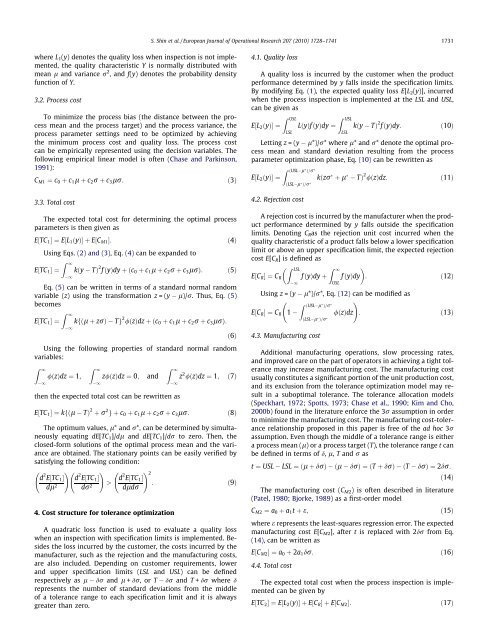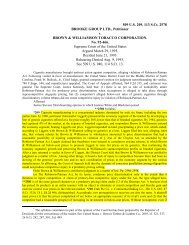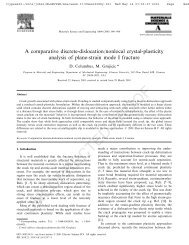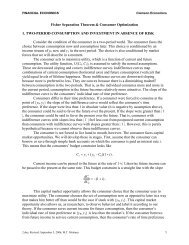Development of the parametric tolerance modeling and optimization ...
Development of the parametric tolerance modeling and optimization ...
Development of the parametric tolerance modeling and optimization ...
Create successful ePaper yourself
Turn your PDF publications into a flip-book with our unique Google optimized e-Paper software.
where L1(y) denotes <strong>the</strong> quality loss when inspection is not implemented,<br />
<strong>the</strong> quality characteristic Y is normally distributed with<br />
mean l <strong>and</strong> variance r 2 , <strong>and</strong> f(y) denotes <strong>the</strong> probability density<br />
function <strong>of</strong> Y.<br />
3.2. Process cost<br />
To minimize <strong>the</strong> process bias (<strong>the</strong> distance between <strong>the</strong> process<br />
mean <strong>and</strong> <strong>the</strong> process target) <strong>and</strong> <strong>the</strong> process variance, <strong>the</strong><br />
process parameter settings need to be optimized by achieving<br />
<strong>the</strong> minimum process cost <strong>and</strong> quality loss. The process cost<br />
can be empirically represented using <strong>the</strong> decision variables. The<br />
following empirical linear model is <strong>of</strong>ten (Chase <strong>and</strong> Parkinson,<br />
1991):<br />
CM1 ¼ c0 þ c1l þ c2r þ c3lr: ð3Þ<br />
3.3. Total cost<br />
The expected total cost for determining <strong>the</strong> optimal process<br />
parameters is <strong>the</strong>n given as<br />
E½TC1Š ¼E½L1ðyÞŠ þ E½CM1Š: ð4Þ<br />
Using Eqs. (2) <strong>and</strong> (3), Eq. (4) can be exp<strong>and</strong>ed to<br />
E½TC1Š ¼<br />
Z 1<br />
1<br />
kðy TÞ 2 f ðyÞdy þðc0 þ c1l þ c2r þ c3lrÞ: ð5Þ<br />
Eq. (5) can be written in terms <strong>of</strong> a st<strong>and</strong>ard normal r<strong>and</strong>om<br />
variable (z) using <strong>the</strong> transformation z =(y l)/r. Thus, Eq. (5)<br />
becomes<br />
E½TC1Š ¼<br />
Z 1<br />
1<br />
kfðl þ zrÞ Tg 2 /ðzÞdz þðc0 þ c1l þ c2r þ c3lrÞ:<br />
Using <strong>the</strong> following properties <strong>of</strong> st<strong>and</strong>ard normal r<strong>and</strong>om<br />
variables:<br />
Z 1<br />
1<br />
/ðzÞdz ¼ 1;<br />
Z 1<br />
1<br />
z/ðzÞdz ¼ 0; <strong>and</strong><br />
Z 1<br />
<strong>the</strong>n <strong>the</strong> expected total cost can be rewritten as<br />
1<br />
ð6Þ<br />
z 2 /ðzÞdz ¼ 1; ð7Þ<br />
E½TC1Š ¼kfðl TÞ 2 þ r 2 gþc0 þ c1l þ c2r þ c3lr: ð8Þ<br />
The optimum values, l* <strong>and</strong> r*, can be determined by simultaneously<br />
equating dE[TC 1]/dl <strong>and</strong> dE[TC 1]/dr to zero. Then, <strong>the</strong><br />
closed-form solutions <strong>of</strong> <strong>the</strong> optimal process mean <strong>and</strong> <strong>the</strong> variance<br />
are obtained. The stationary points can be easily verified by<br />
satisfying <strong>the</strong> following condition:<br />
d 2 E½TC1Š<br />
dl 2<br />
!<br />
d 2 E½TC1Š<br />
dr 2<br />
!<br />
> d2 ! 2<br />
E½TC1Š<br />
dldr<br />
4. Cost structure for <strong>tolerance</strong> <strong>optimization</strong><br />
: ð9Þ<br />
A quadratic loss function is used to evaluate a quality loss<br />
when an inspection with specification limits is implemented. Besides<br />
<strong>the</strong> loss incurred by <strong>the</strong> customer, <strong>the</strong> costs incurred by <strong>the</strong><br />
manufacturer, such as <strong>the</strong> rejection <strong>and</strong> <strong>the</strong> manufacturing costs,<br />
are also included. Depending on customer requirements, lower<br />
<strong>and</strong> upper specification limits (LSL <strong>and</strong> USL) can be defined<br />
respectively as l dr <strong>and</strong> l + dr, orT dr <strong>and</strong> T + dr where d<br />
represents <strong>the</strong> number <strong>of</strong> st<strong>and</strong>ard deviations from <strong>the</strong> middle<br />
<strong>of</strong> a <strong>tolerance</strong> range to each specification limit <strong>and</strong> it is always<br />
greater than zero.<br />
S. Shin et al. / European Journal <strong>of</strong> Operational Research 207 (2010) 1728–1741 1731<br />
4.1. Quality loss<br />
A quality loss is incurred by <strong>the</strong> customer when <strong>the</strong> product<br />
performance determined by y falls inside <strong>the</strong> specification limits.<br />
By modifying Eq. (1), <strong>the</strong> expected quality loss E[L2(y)], incurred<br />
when <strong>the</strong> process inspection is implemented at <strong>the</strong> LSL <strong>and</strong> USL,<br />
can be given as<br />
E½L2ðyÞŠ ¼<br />
Z USL<br />
LSL<br />
LðyÞf ðyÞdy ¼<br />
Z USL<br />
LSL<br />
kðy TÞ 2 f ðyÞdy: ð10Þ<br />
Letting z =(y l*)/r* where l* <strong>and</strong> r* denote <strong>the</strong> optimal process<br />
mean <strong>and</strong> st<strong>and</strong>ard deviation resulting from <strong>the</strong> process<br />
parameter <strong>optimization</strong> phase, Eq. (10) can be rewritten as<br />
E½L2ðyÞŠ ¼<br />
Z ðUSL l Þ=r<br />
ðLSL l Þ=r<br />
4.2. Rejection cost<br />
kðzr þ l TÞ 2 /ðzÞdz: ð11Þ<br />
A rejection cost is incurred by <strong>the</strong> manufacturer when <strong>the</strong> product<br />
performance determined by y falls outside <strong>the</strong> specification<br />
limits. Denoting CRas <strong>the</strong> rejection unit cost incurred when <strong>the</strong><br />
quality characteristic <strong>of</strong> a product falls below a lower specification<br />
limit or above an upper specification limit, <strong>the</strong> expected rejection<br />
cost E[CR] is defined as<br />
E½CRŠ ¼CR<br />
Z LSL<br />
1<br />
f ðyÞdy þ<br />
Z 1<br />
USL<br />
f ðyÞdy : ð12Þ<br />
Using z =(y l*)/r*, Eq. (12) can be modified as<br />
Z ðUSL l Þ=r<br />
!<br />
E½CRŠ ¼CR 1<br />
/ðzÞdz : ð13Þ<br />
ðLSL l Þ=r<br />
4.3. Manufacturing cost<br />
Additional manufacturing operations, slow processing rates,<br />
<strong>and</strong> improved care on <strong>the</strong> part <strong>of</strong> operators in achieving a tight <strong>tolerance</strong><br />
may increase manufacturing cost. The manufacturing cost<br />
usually constitutes a significant portion <strong>of</strong> <strong>the</strong> unit production cost,<br />
<strong>and</strong> its exclusion from <strong>the</strong> <strong>tolerance</strong> <strong>optimization</strong> model may result<br />
in a suboptimal <strong>tolerance</strong>. The <strong>tolerance</strong> allocation models<br />
(Speckhart, 1972; Spotts, 1973; Chase et al., 1990; Kim <strong>and</strong> Cho,<br />
2000b) found in <strong>the</strong> literature enforce <strong>the</strong> 3r assumption in order<br />
to minimize <strong>the</strong> manufacturing cost. The manufacturing cost-<strong>tolerance</strong><br />
relationship proposed in this paper is free <strong>of</strong> <strong>the</strong> ad hoc 3r<br />
assumption. Even though <strong>the</strong> middle <strong>of</strong> a <strong>tolerance</strong> range is ei<strong>the</strong>r<br />
a process mean (l) or a process target (T), <strong>the</strong> <strong>tolerance</strong> range t can<br />
be defined in terms <strong>of</strong> d, l, T <strong>and</strong> r as<br />
t ¼ USL LSL ¼ðlþ drÞ ðl drÞ ¼ðT þ drÞ ðT drÞ ¼2dr:<br />
ð14Þ<br />
The manufacturing cost (CM2) is <strong>of</strong>ten described in literature<br />
(Patel, 1980; Bjorke, 1989) as a first-order model<br />
CM2 ¼ a0 þ a1t þ e; ð15Þ<br />
where e represents <strong>the</strong> least-squares regression error. The expected<br />
manufacturing cost E[CM2], after t is replaced with 2dr from Eq.<br />
(14), can be written as<br />
E½CM2Š ¼a0 þ 2a1dr: ð16Þ<br />
4.4. Total cost<br />
The expected total cost when <strong>the</strong> process inspection is implemented<br />
can be given by<br />
E½TC2Š ¼E½L2ðyÞŠ þ E½CRŠþE½CM2Š: ð17Þ
















